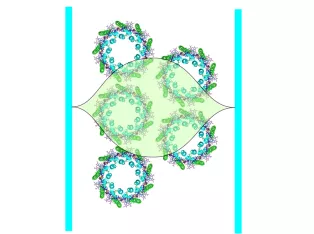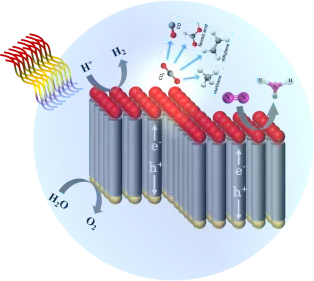Light-active materials
Research areas:
- Polaritons: Microcavity mediate strong light matter interaction
- Perovskite nanocrystal solids
- Efficient Photoelectrode Fabrication for Renewable Energy Technologies
Polaritons: Microcavity mediate strong light matter interaction
Resonance with a cavity mode provides means for strong light-matter interaction. We have prepared a microcavity with a high concentration of photosynthetic light-harvesting complexes and demonstrated Rabbi splitting of the absorption bands of the collective states of the light-harvesting complexes and the cavity mode – the so-called polaritons. In the follow-up work we use exciton-exciton annihilation as the witness of cavity-mediated energy transfer between the light-harvesting complexes.
Contact person:
Key publications:
- F. Wu, et al, Optical cavity-mediated exciton dynamics in photosynthetic light harvesting 2 complexes. Nat. Comm. 2022, 13, 6864
Perovskite nanocrystal solids
Colloidal perovskite nanocrystals are highly luminescent materials that emerged in the past decade. Modern chemical syntheses enable the preparation of uniform perovskite nanocrystals which self-assemble into ordered microscopic solids. Such solids are fundamentally interesting because of the possibility of engineering the interactions between nanocrystals and realizing exotic phenomena such as superradiance. Fabricating these materials and studying their light-matter interactions is the focus of this research area.
Efficient Photoelectrode Fabrication for Renewable Energy Technologies
Project: Photoelectrodes for solar catalysis
Semiconductors are unique materials that can generate free electrons and hole pairs upon exposure to sunlight (photons). These electrons and holes are free fuels that can be extracted from the exposed photoelectrode using efficient reductive and oxidative catalysts. These catalysts must be efficient, earth-abundant, and environmentally friendly so that the solar catalysis process may be used on a large scale. We develop these photoelectrodes using earth-abundant materials such as silicon and hematite. These photoelectrodes perform solar-assisted reactions such as water splitting, CO2, and N2 reduction. I further modify these electrodes to be biocompatible to convert biomass derivatives into biofuels and biopolymers. Our (photo)/electrochemical system is investigated using the combination of various time-resolved optical and high-energy X-rays.
Contact persons:
- Anurag Kawde
- Jens Uhlig
Key publications:
- A. Kawde et al, Photo-electrochemical hydrogen production from neutral phosphate buffer and seawater using micro-structured p-Si photo-electrodes functionalized by solution-based methods, Sustainable Energy Fuels, 2018, 2, 2215
- A. Kawde et al, A microstructured p-Si photocathode outcompetes Pt as a counter electrode to hematite in photoelectrochemical water splitting, Dalton Trans., 2019, 48, 1166-1170
- A. Kawde, More than protection: The function of TiO2interlayers in hematite functionalized Si photoanodes, Phys. Chem. Chem. Phys., 2020, 22, 28459
Project: Environmental friendly earth-abundant photoelectrodes for biohybrid applications
The reaction that has attracted considerable interest to replace water oxidation (O2 production) in recent years is the oxidation of 5-hydroxymethylfurfural (5-HMF) to 2,5- furan-dicarboxylic acid (FDCA. While 5-HMF constitutes an essential platform for a large number of chemicals, including fuels, solvents, and polymer building blocks, FDCA is regarded as a sustainable alternative to terephthalic acid in the production of polyester polyethylene 2,5-furan-dicarboxylate (PEF) with better thermomechanical and barrier properties than polyethylene terephthalate (PET). FDCA is produced from 5-HMF through three oxidation steps, which can take two routes, as shown in Scheme. We have developed bio-compatible photoelectrodes using earth-abundant hematite. This work is shown as proof of principle for producing FDCA using abundant solar energy.
Contact persons:
- Anurag Kawde
- Jens Uhlig
- Tönu Pullerits
Key publication:
- A. Kawde et al, Photoelectrochemical Oxidation in Ambient Conditions Using Earth-Abundant Hematite Anode: A Green Route for the Synthesis of Biobased Polymer Building Blocks, Catalysts 2021, 11(8), 969.




